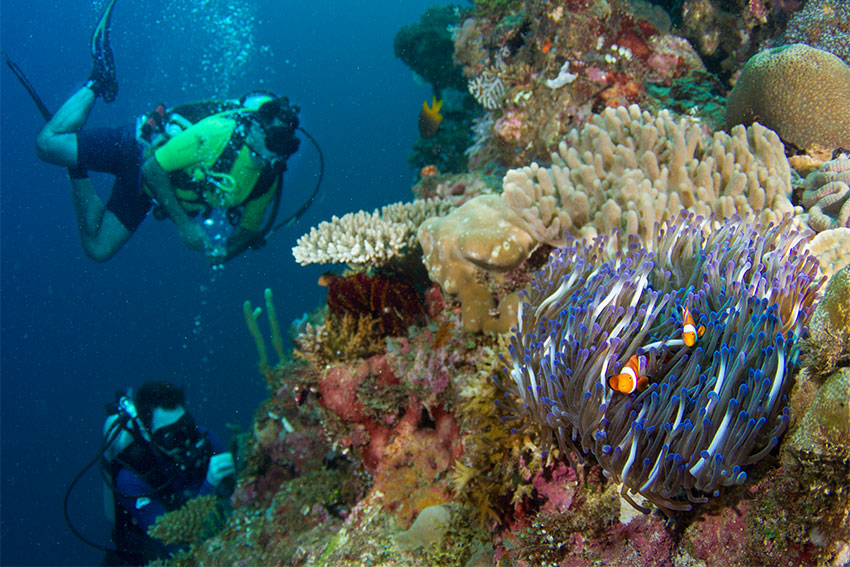Scaring Nemo

How do clownfish on coral reefs react to encounters with humans?
Human intervention is putting marine ecosystems under increasing pressure. On coral reefs, rising water temperatures, ocean acidification, pollution from plastic waste or overfishing threaten the organisms living there - be they fish, sea cucumbers or corals. But how does the direct physical presence of humans under water change the behaviour and ecology of animals on coral reefs?
Researchers from AUT and the Leibniz Centre for Tropical Marine Research (ZMT) in Bremen studied the behaviour of anemone fish during encounters with humans off the coast of Vanuatu in the South Pacific. The team, consisting of fish ecologist Dr Julian Lilkendey (ZMT), marine biologist Dr Armagan Sabetian (AUT) and AUT marine biology student Lena Trnski came to some surprising results which have been published in the Journal of Fish Biology.
Anemonefish, also known as clownfish, are not only the cute protagonists in the hit movie "Finding Nemo", they are also in demand as actors in science and often serve as model organisms for behavioral studies on fish. Clownfish live in symbiosis with sea anemones; the anemone offers the fish protection from attackers in its tentacles while the clownfish defends it from invaders and provide it with nutrition through its food remains and excrements. When guarding their host anemone, the fish show easily distinguishable behaviours. The close connection to their fixed-in-place anemone makes clownfish particularly susceptible to human presence because they can only avoid an encounter with humans underwater for a limited time due to the small size and localization of their anemone.
During their investigations in Vanuatu, the researchers focused on two species of clownfish - the Clark's anemonefish and the dusky anemonefish. They wanted to know whether these species changed their behavior when encountering humans. Lead author Lena Trnski snorkeled out to the reefs off Efate island and videoed the reactions of clownfish. To simulate the presence of an observer, she hovered one to three meters above the anemone. However, she was not present during the video recordings recorded as control for comparison. At home on her laptop, she noted the behavior of each fish in the anemone at 15-second intervals. A total of 60 behavioural events were recorded for each anemone fish, both in Lena's presence and in her absence.
When confronted with human presence, the two species showed very different behavioural patterns, according to the researchers. "While Clark's anemonefish were frightened by encounters with humans and often hid deep within the tentacles of the anemone, the dusky anemonefish reacted less to the presence of a human," reports study leader Dr. Julian Lilkendey. "We actually expected that the dusky anemone fish would also hide from Lena or even attempt to chase her away, but they usually did not let her disturb them. Individuals were often up to a metre outside the tentacles of their anemone.
"We suspect that dusky anemonefish display a rather bolder behaviour in the presence of humans, as they are a highly specialised species that can only inhabit a few species of anemone," Trnski explains. "In order to find a suitable host anemone, the dusky anemonefish can benefit from fearlessly searching the reef - even if this behaviour also makes them more susceptible to predators. But it is precisely this fearlessness that is also revealed by the fact that they do not flee from humans.
Courage pays off
Their observations led the researchers to conclude that in regions with a high level of tourism, 'courageous' clownfish species such as the dusky anemonefish could displace more fearful species. "Species that retreat into their anemones for protection under stress spend a lot of energy and time on this one escape behaviour and are therefore less able to engage in foraging or reproduction," says Lilkendey. "Intrepid species have an advantage over them.”
"The resulting displacement process would ultimately lead to a loss of species diversity," Trnski adds.
"The ecological consequences of behavioural changes caused by human presence are still largely unexplored," says Lilkendey. "We suspect that differences in the behaviour of individual animals could have an impact on interactions between species, such as predator-prey relationships or symbioses, which in turn affect community structures and the functioning of the entire ecosystem".
Trnski, L., Sabetian, A., Lilkendey, J. (2020) Scaring Nemo – Contrasting effects of observer presence on two anemonefish species. Journal of Fish Biology.